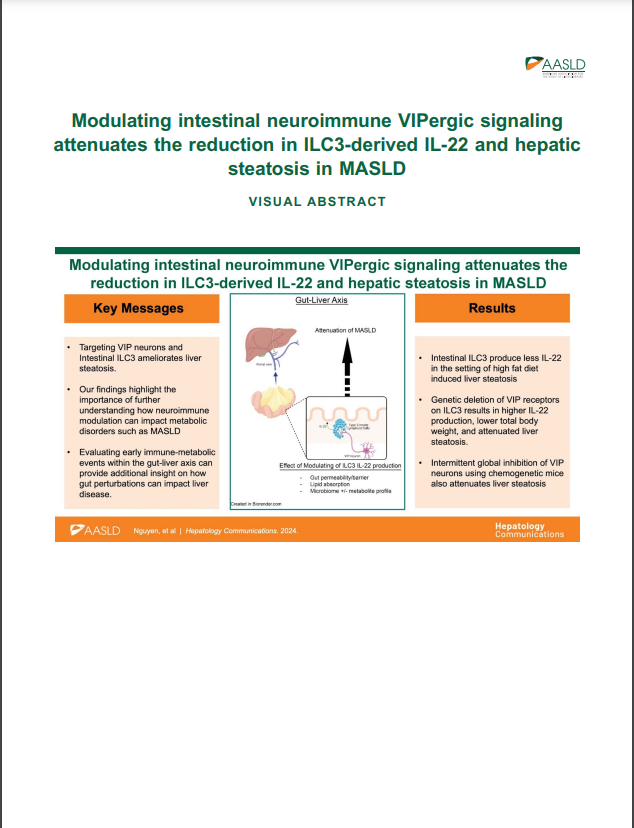Modulating intestinal neuroimmune VIPergic signaling attenuates the reduction in ILC3-derived IL-22 and hepatic steatosis in MASLD
September 2024
Hepatology Communications
Abstract
Background:
Metabolic dysfunction–associated steatotic liver disease (MASLD, formerly known as NAFLD) is a major driver of cirrhosis and liver-related mortality. However, therapeutic options for MASLD, including prevention of liver steatosis, are limited. We previously described that vasoactive intestinal peptide–producing neurons (VIP-neurons) regulate the efficiency of intestinal dietary fat absorption and IL-22 production by type 3 innate lymphoid cells (ILC3) in the intestine. Given the described hepatoprotective role of IL-22, we hypothesize that modulation of this neuroimmune circuit could potentially be an innovative approach for the control of liver steatosis.
Methods:
We used a model of diet-induced MASLD by exposing mice to a high-fat diet (HFD) for 16 weeks, when the development of liver steatosis was first observed in our animals. We characterized IL-22 production by intestinal ILC3 at this dietary endpoint. We then evaluated whether communication between VIP-neurons and ILC3 affected IL-22 production and MASLD development by exposing mice with a conditional genetic deletion of Vipr2 in ILC3 (Rorc(t)CreVipr2fl/fl) to the HFD. We also performed intermittent global inhibition of VIP-neurons using a chemogenetic inhibitory approach (VipIres-CrehM4DiLSL) in HFD-fed mice.
Results:
Production of IL-22 by intestinal ILC3 is reduced in steatotic mice that were exposed to an HFD for 16 weeks. Targeted deletion of VIP receptor 2 in ILC3 resulted in higher production of IL-22 in ILC3 and was associated with a significant reduction in liver steatosis in mice under HFD. Global inhibition of VIP-producing neurons also resulted in a significant reduction in liver steatosis.
Conclusions:
Modulating VIPergic neuroimmune signaling can ameliorate the development of hepatic steatosis induced by a surplus of fat ingestion in the diet. This neuroimmune pathway should be further investigated as a potential therapeutic avenue in MASLD.

